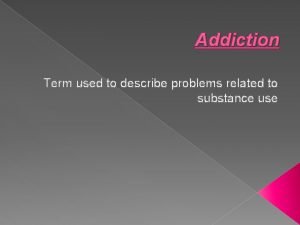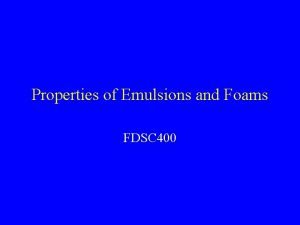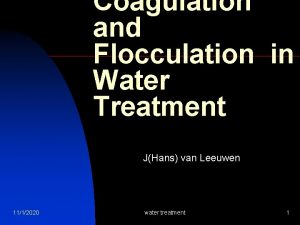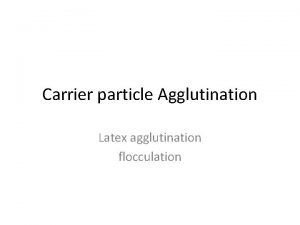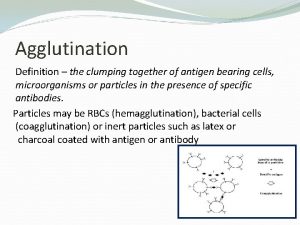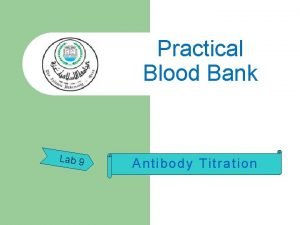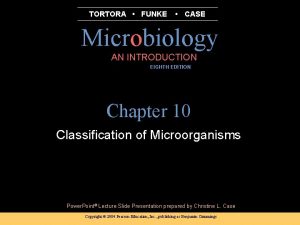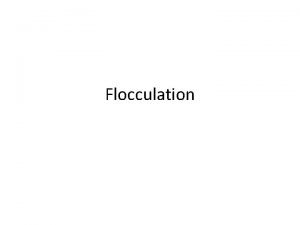Carrier particle Agglutination Latex agglutination flocculation Carrier particle


















- Slides: 18

Carrier particle Agglutination Latex agglutination flocculation

Carrier particle agglutination test • Agglutination test: Qualitative/ Quantitative(Ab titer) agglutination test. It is used to determine Ag or Ab presence and amount(titer) • Carrier particles: Latex, RBC’s, charcoal, protein A of Staph. Aureus. • It is an indirect test. • It is used to detect Ag or Ab in the patient sample. • Latex particles are inert polystyrene substance(0. 790. 81 mm). Ag or Ab attach spontaneously to it.

Latex Agglutination Test Rheumatoid arthritis (RA) • Is traditionally considered a chronic, inflammatory autoimmune disorder that causes the immune system to attack the joints. • It is a disabling and painful inflammatory condition, which can lead to substantial loss of mobility due to pain and joint destruction. • RA is a systemic disease, often affecting extra- articular tissues throughout the body including the skin, blood vessels, heart, lungs, and muscles. • About 60% of RA patients are unable to work 10 years after the onset of their disease.

• The Rheumatoid arthritis immune response appears to be directed against multiple antigenic determinants on the gamma globulin molecule. ( Anti-Ig. G) • In the test kit, latex particles are coated with human gamma globulin Ig. G molecule. • In the screening test, however, positive results may also be obtained due to others disorders such as: • Systemic Lupus Erythematosis (SLE) • Polyarteritis nodosa • Dermatomyositis or Scleroderma. Some diseases such as Cirrhosis, Hepatitis, , Syphilis, Sub acute bacterial endocarditis and Lymphomas may also give rise to agglutination reactions. Titers in these conditions are usually less than 1: 20

Method: • Sample collection: • Collect 5 – 10 ml venous blood into sterile tube without anticoagulant • Allow to clot at room temp. • Formation of clot must be complete • Separate serum and store at 2 -8 °C • It is preferable to test samples within 2 -3 days

Method: • Screening test • Bring all reagents to room temp. • Prepare 1: 20 dilution of test serum by adding 50 μl of serum to 1 ml of glycine buffer • Place 50 μl of diluted serum on to the test slide • Add 1 drop of well shaken latex reagent • Mix the two drops together with a clean stirrer and spread out to the edge of the test area • Rock the slide gently and observe for macro agglutination • Read at 2 minutes under a direct light source • A definite clumping is reported as reactive (R). • No clumping is reported as non-reactive (N).

CRP Latex Kit • C-reactive protein (CRP) is a non-specific test. • It is used by a doctor to detect inflammation if there is a high suspicion of tissue injury or infection somewhere in the body, but the test cannot tell where the inflammation is or what condition is causing it. • CRP is not diagnostic of any condition, but it can be used together with signs and symptoms and other tests to evaluate an individual for an acute or chronic inflammatory condition

CRP Latex Kit

CRP Latex Agglutination test • The same principle of Latex kits. • CRP is a protein present normally in human serum. • Anti-CRP is coated on latex to detect CRP in patient sample. • CRP is used mainly as a marker of inflammation • It may also be ordered on a regular basis to monitor conditions such as rheumatoid arthritis and Lupus and is often repeated at intervals to determine whether treatment is effective

CRP Test Elisa Kit Latex kit Latex Kit

Flocculation Test Rapid Plasma Reagin (RPR) • Syphilis is a sexually transmitted disease caused by the spirochete Treponema pallidum. • The RPR (Rapid Plasma Reagin) Card test is a presumptive serologic screening test for syphilis. • The serum of a person with syphilis contains a non-specific anti-lipid antibody (termed Reagin), which is not found in normal serum.

• Syphilis infection starts the breakdown of the patient's own tissue cells. • Fatty substances which are released, combine with protein from Treponema pallidum to form an antigen which stimulates the body to produce antibodies against both the body's tissue lipids (non-specific or non-treponemal) as well as the T. pallidum protein (specific or treponemal). • The RPR Card test detects the nonspecific antilipid antibody and is referred to as a non- treponemal test for syphilis.

Principle of the Method • The RPR test is a non-treponemal slide agglutination test for the qualitative and semiquantitative detection of plasma reagins in human serum. • Carbon particles coated with a lipid complex are agglutinated when mixed with samples containing reagins.

• The known RPR antigen consists of Cardiolipin, lecithin, and cholesterol bound to charcoal particles • Charcoal makes the reaction visible. • If the patient has syphilis, the antilipid antibodies (Reagin) in his/her serum will crossreact with the known RPR lipid antigens giving a visible clumping of the charcoal particles.

Procedure: • Place 50 µl of sample and one drop of each +ve and –ve controls into separate circles on the test slide. • Swirl the RPR-carbon reagently before using. • Place the micropipette in a vertical position and perpendicular to the slide, and add one drop (20 µl) of this reagent next to the samples to be tested. • Mix the drops with a stirrer, spreading them over the entire surface of the circle. Use different stirrers for each samples. • Place the slide on a mechanical rotor (shaker) at 80 -100 r. p. m. for 8 minutes. • Read the test results immediately.

Read the results as follows: • A definite clumping of the charcoal particles is reported as reactive (R) • No clumping is reported as non-reactive (N).

Co-agglutination • Protein A which is a cell wall component of Staphylococcus aureus is able to bind to Fc portion of most Ig. G Ab leaving Fab portion free to interact with Ag present in specimens. • This test is used to detect Ag in specimens or isolated bacteria from cultures. • Example: streptococcal serotyping, Bacterial Ag detection kit for meningitis.

Co-agglutination • It is an agglutination where Ab is coated on protein A of Staph. aureus. Co-agglutination + TEST Ag Coated Ab on Staph protein A
 Flocculation delirium
Flocculation delirium Flocculation geography definition
Flocculation geography definition Hydraulic flocculator
Hydraulic flocculator Flocculation
Flocculation Grading agglutination reactions
Grading agglutination reactions Agglutination
Agglutination Grading agglutination reactions
Grading agglutination reactions Define agglutination
Define agglutination Golongan darah cis ab
Golongan darah cis ab Abo grouping
Abo grouping Reverse passive agglutination
Reverse passive agglutination Kppers
Kppers What is agglutination
What is agglutination Agglutination grading
Agglutination grading Microplate method for blood grouping
Microplate method for blood grouping Allomorph
Allomorph Phage typing
Phage typing Passive agglutination test
Passive agglutination test Finnish agglutination
Finnish agglutination
